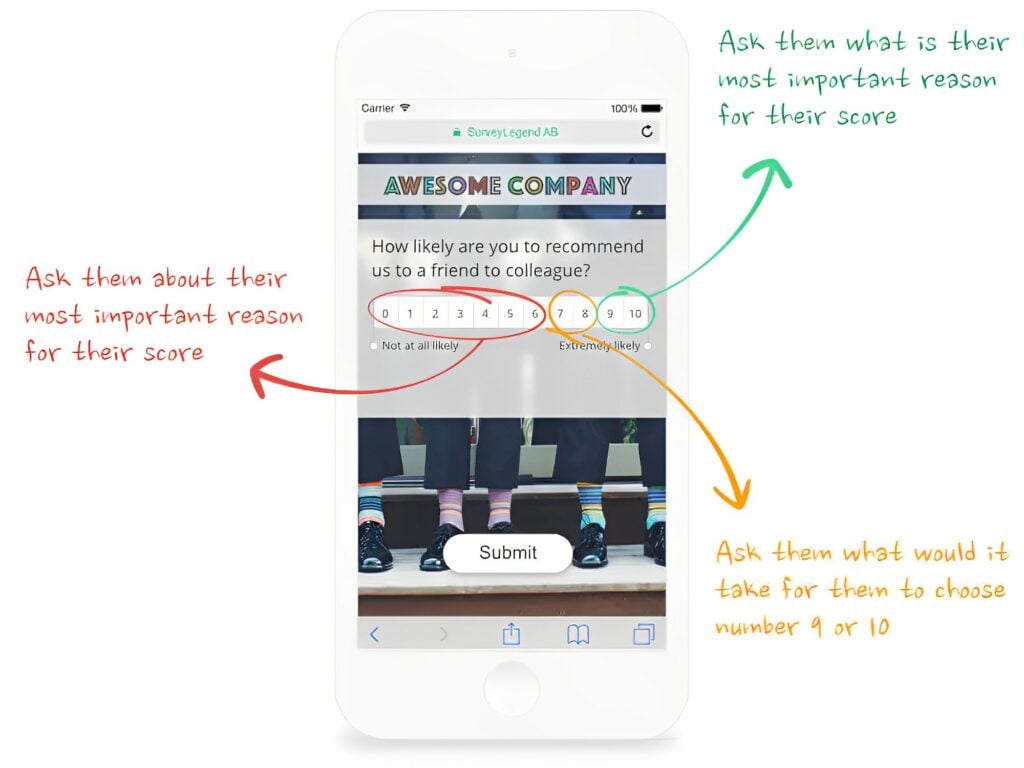The world is changing and today inclusivity is more important than ever, with groups formerly seen as minorities expected to reach majority status by 2045. But inclusivity isn’t just about race, ethnicity, and gender; it also must take into account age, class, religious or political affiliation, sexual orientation, disability status, and more (there are a whopping 200+ terms in the ONGIG Diversity & Inclusion Glossary). In this blog, we aim to help you create inclusive survey questions that take DEI (diversity, equity, and inclusion) factors into consideration.
Create your FREE inclusive survey, form, or poll now!
Why Create Inclusive Survey Questions?
Simply put, representation matters. Inclusivity demonstrates respect for all individuals and their identities, experiences, and backgrounds. By creating inclusive survey questions, you help ensure that a broader range of perspectives are considered, making your survey results more representative of the population you are studying. Surveys that consider diverse viewpoints are also more likely to yield valid results. Inclusive questions can capture the nuances of different experiences and perspectives, making the data richer and more insightful.
Inclusive surveys also help to minimize bias by ensuring that questions and response options do not favor or marginalize any particular group. This promotes fairness and objectivity in data collection. Further, being inclusive helps avoid cultural insensitivity or offensive language, ensuring that survey respondents from various cultural backgrounds feel respected and understood.
12 Ways to Create Inclusive Survey Questions
Creating inclusive surveys that consider diversity, equity, and inclusion (DEI) factors is essential to ensure that all respondents feel respected and represented. Here are some ways to create inclusive survey questions that respect various aspects of diversity and garner you better data and higher response rates.
1. Educate Survey Administrators
This may seem like a no-brainer, but some survey administrators may not have ever focused on inclusivity and matters related to DEI. If you’re creating an inclusive survey, be sure to train survey administrators to be respectful when discussing sensitive topics and handling survey-related issues. Be sure to read our blog How to Ask Sensitive Survey Questions for more information.
2. Use Inclusive Language
Unintentionally leaving out a group, or forcing them to fit into a group, can be offensive. Here are some examples.
- When asking about race or ethnic groups, it’s not always black and white (pun intended). Many people identify with multiple races or ethnicities, so include an option to “Select all that apply.”
- When asking about sexual orientation (straight, gay, bisexual), do not include “gender identity.” Transgender and non-binary are not considered “orientations,” but rather how someone identifies, and should be in the “gender” category.
- Now, instead of simply asking “What is your gender?” you may consider asking “What is your gender or gender identity?” Today, it’s important to include options beyond just “male” and “female” like “non-binary,” “prefer not to say,” or an open text field.
- Don’t assume a disabled person considers themselves disabled. Instead, carefully word your question similar to this: “Do you identify as a person with a disability or are you a person with accessibility needs?”
3. Offer Multiple Choices
Some survey questions are notorious for not providing an ‘out’ which can leave some participants perplexed. Always offer an “Other” or “Prefer not to say” option. You can also include a write-in option for respondents to specify things that may not be covered by the provided choices. Many of these types of survey questions come up in the demographic category, so be sure to check out our blog 15 Demographic Survey Questions and How To Ask Them.
4. Test for Clarity and Sensitivity
It’s always a good idea to pre-test your DEI survey with a diverse group of individuals to ensure it is clear, sensitive, and respectful of all identities and backgrounds. Be sure to listen to their suggestions and take their recommendations to heart.
5. Use Inclusive Images
If you are creating a survey with images, be sure to use photos and icons that represent a diverse range of identities and backgrounds. Of course, don’t be too obvious; the best way to show diversity is naturally. As you can see in the SurveyLegend example below, numerous races are represented in this question. The survey isn’t even about DEI or inclusivity; it’s about teachers. However, it’s always good practice to be inclusive with survey images.

6. Avoid Stereotyping
Stereotyping can lead to skewed results and misrepresent the views and experiences of respondents. While stereotypes based on gender, race, income, and so on may seem obvious, there are other ways stereotypes can be introduced into a survey – and they can be negative or positive. For example, consider this one based on age groups:
Which of the following best describes the typical behavior of millennials? Select one:
- Entitled and lazy
- Tech-savvy and innovative
- Disinterested in traditional values
In this example, the first option perpetuates a negative stereotype about millennials, while the second option promotes a positive stereotype. Both options can lead to biased responses. To avoid stereotypes, be sure to frame questions and answer choices in a way that avoids reinforcing stereotypes or assumptions about certain groups.
7. Prioritize Survey Privacy and Anonymity
If true, always assure respondents that their data will be kept confidential and anonymous to encourage honesty. Create an introduction page or survey welcome page on your online surveys that highlight this to help put participants at ease and ensure the best results for you.
8. Consult with DEI Experts
DEI is a sensitive matter. Not sure if you’re doing it right? Consult with DEI experts or organizations to review and advise on survey questions and content. ONGIG is one organization that will review what you’re doing and make sure you’re doing it right. Also, be sure to read our blog on Asking Sensitive Questions on a Survey.
9. Consider Intersectionality
Acknowledge that individuals may have multiple intersecting identities. For example, a person may be black and also disabled. Their experiences could be different from others who are black but not disabled, or disabled but not black. Be sure to design questions that respect these complexities.
10. Consider Cultural Sensitivity
Be aware of cultural differences and sensitivities when designing your questions. What may be acceptable or sensitive in one culture may differ from another. While some insensitive questions are obvious, others are not. For example, on a food survey, asking “Have you ever tried exotic ethnic foods, like sushi or curry?” may seem harmless, however it could be perceived as culturally insensitive because it refers to foods from diverse cultures as “exotic,” implying that they are unusual or foreign. This can reinforce stereotypes.
11. Offer Skipping and Skip Logic
Allow respondents to skip questions that may not apply to them based on their demographic characteristics. This helps ensure they will continue with the survey even if they get stuck on a question they can’t, or don’t want, to answer.
You can also employ survey skip logic to make your survey smarter by guiding participants to different questions based on their responses. SurveyLegend makes it easy to include skip logic based on participant responses. The example below highlights how different responses would lead to different outcomes.

12. Monitor Survey Response Bias and Allow Feedback
It’s important to regularly review survey data to identify potential survey response bias or underrepresentation of certain groups and make adjustments as necessary. Only this way will you have a true representation of your survey audience. You should also consider including a way for respondents to provide feedback on the survey’s inclusivity and suggest improvements. Their input and ideas could make your next survey that much better.
Conclusion
Creating inclusive surveys is not just a matter of courtesy; it’s a best practice that helps ensure the accuracy, fairness, and ethical integrity of your research. It helps gather more complete and representative data, which can lead to more informed decisions and better outcomes for all stakeholders. Of course, no matter how careful you are when writing questions, mistakes or oversights can happen. Be sure to check out our blog on creating DEI surveys in the workplace for more important tips. Ready to create your inclusive survey now? Start with our free survey maker today!
Do you make a habit of creating inclusive survey questions? Have you ever been offended by a survey question? Let us know in the comments!
Create your FREE inclusive survey, form, or poll now!
Frequently Asked Questions (FAQs)
An inclusive survey is designed and conducted in a way that respects and includes the perspectives, experiences, and identities of all individuals, regardless of their background, characteristics, or identities. Inclusivity in surveys is important to ensure that the data collected accurately represents the diversity of the population being studied and to avoid biases or discrimination.
DEI stands for Diversity, Equity, and Inclusion. It is designed to capture the culture of organizations that manage diverse workforces and work toward providing the opportunity for everyone to succeed and participate regardless of their background.
Awareness is the first step in avoiding stereotypes. Educate yourself and your team about common stereotypes associated with various demographic groups (e.g., race, gender, age, religion) so that you don’t unknowingly introduce them into your survey questions. You should also pilot test your survey with a diverse group of individuals to identify any potential issues related to stereotypes or bias in the questions.




